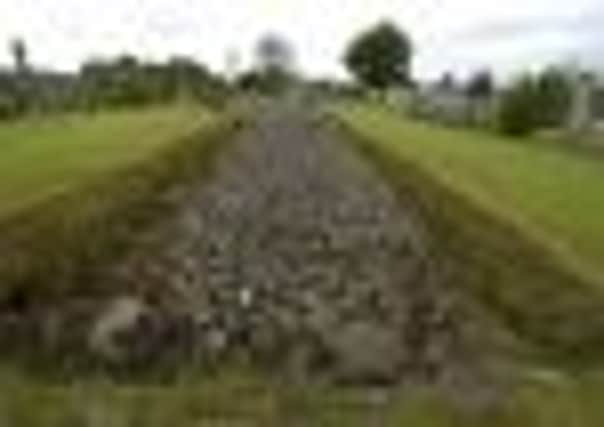Rome’s final Scottish frontier to be promoted


Real Roman Tours operator Douglas Eckhart, attired as Quintus Valerius Maximus of Legio VI, and Rufus, a fellow soldier, will be “in character” from the moment their 12-seater minibus leaves East Market Street, in Edinburgh, bound for sites along the Antonine Wall, near Falkirk.
Mr Eckhart, who has an MA in ancient history from the University of Edinburgh and is a member of the living history group, The Antonine Guard, said he decided to start the tour because he believes Roman history in Scotland, is greatly under represented.
Advertisement
Hide Ad“I do a lot of hillwalking and have stumbled across the remains of Roman camps and fortifications. But the general public don’t seem to be aware of the role of the Romans in Scotland,” said Mr Eckhart, 38, from Edinburgh.


“The general impression seems to be that they “came up to Hadrian’s Wall and stopped.” This is not true. They came up to the Lowlands but never conquered but still had a military presence. This is a story which I believe is still to be told,” said Mr Eckhart.
He added that despite two recent Hollywood films, The Eagle (2011) starring Jamie Bell and Channing Tatum and Centurion (2010) starring Michael Fassbender and Dominic West about the disappearance of 5,000 soldiers from the legendary Ninth Legion in 108AD, Scotland was still not promoting the full potential of this era.
The 40-mile Antonine Wall was built in the AD140s on the orders of Emperor Antoninus Pius as a defence against the northern tribes and ran from the Firth of Forth to the Firth of Clyde. It was abandoned after about two decades when Rome’s military priorities altered and it was deemed too costly and unnecessary to hold Lowland Scotland.
In character
Participants will be able to ask the soldiers questions ranging from what it was like to be part of an occupying force in hostile terrain - which Mr Eckhart says has parallels with the current military action in Afghanistan - to what they earned or where they went to drink, just after the time of Christ.
At lunchtime the soldiers will share their rations of garum - a fermented Roman fishy relish - based on anchovies which was prepared by rotting fish guts and wine for many days in the sun.
Advertisement
Hide AdAdrian Mahoney, Falkirk Council’s convener of leisure, tourism and community, said the tour would help boost tourism along the 40-mile long barrier which was designated as a UNESCO World Heritage Site in 2008 a part of the Frontiers of the Roman Empire World Heritage Site, which includes Hadrian’s Wall in England.
“I’m very keen to see more people visit the Antonine Wall which is Scotland’s fifth World Heritage Site. A private commercial tour like this is great but I think we also need to do more by learning a lot from our English partners at Hadrian’s Wall and lobbying the Scottish Government for more funding to make the visitor experience better.
Advertisement
Hide AdThe £30 tours which start in May have a number of stop offs including the earthwork remains of the Roman Fort at Rough Castle near Falkirk which Eckhart says is the most impressive and which allows visitors to visualise one of the 17 larger Auxiliary forts that formed the final plan of the Wall.
Other stops include Callander House in Falkirk which has the earthwork remains of the wall running through the estate and where the v-shaped ditch the Romans dug as part of the frontier system is particularly evident.
Callander House also has a small Roman exhibition featuring a collection of Roman objects discovered on various archaeological digs along the Wall.
After a lunch break at the Millennium Wheel the tour heads to Bo’ness and the Kinneil Estate to visit the remains of a Roman Fortlet and the Kinneil Museum featuring an exhibition of 2000 years of history.
The final stop is the Bridgeness Slab, a recently installed replica of the original slab, which marked the eastern end of the Antonine Wall.
Geoff Bailey, archeologist at Falkirk Museum based at Callander House and author of “The Antonine Wall”, said: “The Antonine Wall is overlooked because just about everyone goes to Hadrian’s Wall.
Advertisement
Hide Ad“But the remains of the wall go through some fantastic countryside and our museum has some great Roman objects such as sword and jewellery including a ring with a carving of Nemesis made of the semi-precious stone corellian.”
Liz Buchanan, regional director of VisitScotland, said: “Anything that contributes to the tourism offering in the Falkirk area and indeed to Scotland as a whole is to be commended. History and heritage are crucial elements of a holiday in Scotland and something that we are keen to highlight in all our marketing activity.
Advertisement
Hide Ad“Clearly this young entrepreneur has recognised a niche in the market and developed a tour that highlights and showcases Scotland’s links with the Romans. This demonstrates the viability of the tourism industry and further underlines the importance of it to the Scottish economy.”
• For more information on the tours, visit http://www.realromantours.com